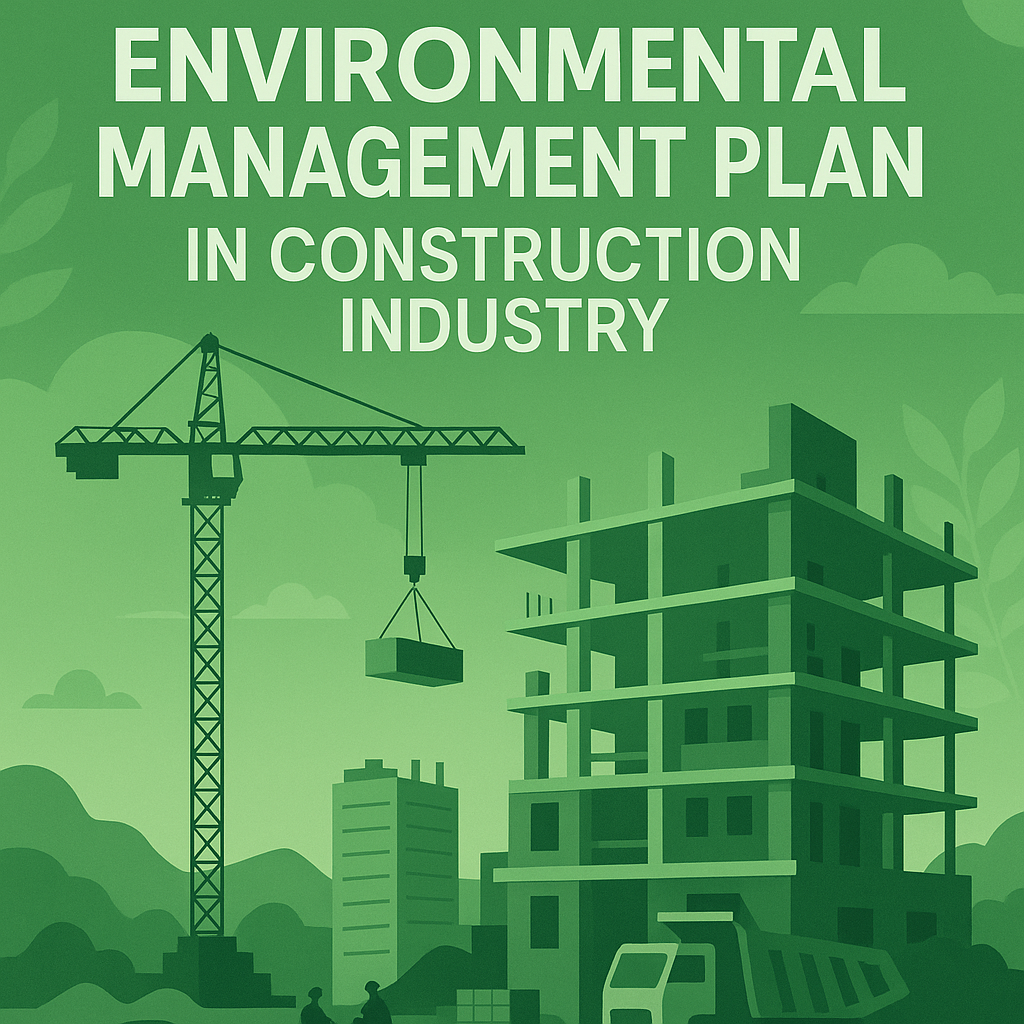Kenya’s skyline is evolving fast. From the Nairobi Expressway slicing through the city to high-rise apartments shaping the outskirts of towns, the construction sector is booming. But as steel and concrete rise, so do concerns about environmental degradation.
Behind every successful construction project should lie a well-executed Construction Site Environmental Management Plan, not just to tick a regulatory box, but to ensure we protect our land, water, air, and communities.
So, what does it really mean to manage a construction site responsibly in Kenya?
What is Construction Site Environmental Management?
Construction Site Environmental Management refers to a set of practices, procedures, and plans that aim to prevent or reduce environmental harm arising from construction activities. This includes:
- Identifying environmental risks before and during construction
- Implementing control measures to manage dust, noise, waste, and water pollution
- Complying with Kenya’s environmental laws and NEMA guidelines
- Preparing and executing an Environmental Management Plan (EMP)
It’s essentially about balancing development with environmental protection — ensuring that today’s buildings don’t compromise tomorrow’s ecosystems.

Legal Framework in Kenya: Know the Law or Pay the Price
Kenya has a robust set of environmental laws and regulations. If you’re operating a construction site, you need to be familiar with these, not just for compliance, but to avoid fines, license revocation, or project shutdowns.
1. Environmental Management and Coordination Act (EMCA), Cap 387
This is the cornerstone of environmental law in Kenya.
Section 58 of EMCA: Any person proposing to undertake a project listed in the Second Schedule (which includes construction of buildings, roads, bridges, waterworks, etc.) must carry out an Environmental Impact Assessment (EIA) and obtain a license from NEMA before starting construction.
2. Environmental (Impact Assessment and Audit) Regulations, 2003
These regulations specify how to conduct EIAs, prepare EMPs, and submit annual environmental audits. Any approved EIA must include an EMP, detailing how negative impacts will be avoided or minimized during the construction and operational phases.
3. Noise and Excessive Vibration Pollution Control Regulations, 2009
These regulations govern permissible noise levels. Construction should be restricted to daytime hours and sound levels must not exceed set decibel limits in residential, commercial, or mixed-use zones.
4. Waste Management Regulations, 2006
Construction waste must be segregated, stored safely, and disposed of through NEMA-licensed handlers. Burning or illegal dumping of waste is a punishable offense.
5. Water Act, 2016 & Public Health Act, Cap 242
Control of water pollution, drainage of stormwater, and proper sanitation on site are covered here. Water abstraction, if any, requires a permit from the Water Resources Authority (WRA).
Common Environmental Risks on Construction Sites in Kenya
Let’s look at the typical environmental problems faced on construction sites, and what’s expected to mitigate them:
| Environmental Aspect | Common Issues | Mitigation Measures |
|---|---|---|
| Air Quality | Dust from excavation, trucks, cement | Water sprinkling, covering trucks, limiting speed, dust screens |
| Noise and Vibrations | Machinery, hammering, piling | Mufflers, noise barriers, daytime work schedules |
| Water Pollution | Runoff into rivers, oil spills | Silt traps, bund walls, spill kits, oil separators |
| Solid Waste | Rubble, packaging, plastics | Segregation, collection points, licensed disposal |
| Hazardous Waste | Paints, solvents, batteries | Labeling, secure storage, disposal through licensed handlers |
| Biodiversity Loss | Clearing vegetation, disturbing habitats | Avoidance zones, re-vegetation, wildlife corridors |
The Environmental Management Plan (EMP): The Backbone of Site Management
An Environmental Management Plan (EMP) is a comprehensive document attached to every approved EIA. It serves as a roadmap for preventing, managing, and monitoring environmental impacts on the construction site.
Key Components of a Good EMP in Kenya:
- Mitigation Measures
- Detailed actions to address each identified risk (dust control, waste handling, etc.)
- Clearly assigned responsibilities for implementation.
- Environmental Monitoring Plan
- What to monitor (e.g., noise levels, water quality, air emissions)
- Frequency (daily, weekly, monthly)
- Who will monitor (site supervisor, environmental officer, third party)
- Compliance and Legal Obligations
- Relevant legal provisions (EMCA, OSHA, etc.)
- Required licenses and permits (e.g., water abstraction, waste transport)
- Emergency Preparedness Plan
- Response strategies for spills, fires, chemical leaks, or natural disasters
- Availability of spill kits, fire extinguishers, first aid kits
- Training and Awareness
- Induction programs for workers
- Toolbox talks on waste segregation, pollution control, PPE use
- Record Keeping
- Waste disposal records, inspection logs, environmental incident reports
- Evidence to be used during NEMA audits
- Decommissioning Plan
- Restoration of the site after construction
- Safe removal of temporary structures and rehabilitation of vegetation
TIP: Make sure your EMP is not just a document, it should be integrated into daily site management.

Roles and Responsibilities on Site
A successful environmental management strategy depends on clear role delegation. Here’s who does what:
- Contractor: Implements EMP on a daily basis; ensures site workers follow environmental procedures.
- Project Environmental Officer: Oversees compliance, monitors impacts, trains staff, liaises with NEMA.
- Supervising Consultant/Resident Engineer: Monitors contractor performance and ensures EMP is being implemented.
- NEMA/County Officers: Conduct inspections and enforce compliance with licensing conditions.
Environmental Audits: A Mandatory Follow-Up
Once construction begins, projects are legally required to submit annual Environmental Audit (EA) Reports to NEMA. This shows whether the EMP is being implemented effectively and if any new issues have emerged.
An EA Report should include:
- Current site conditions
- Compliance status with the EMP
- Environmental incidents (if any)
- Recommendations for improvement
Failure to submit environmental audits or non-compliance with EMPs may lead to penalties under Section 143 of EMCA — fines of up to KSh 2 million or imprisonment.
Going Beyond Compliance: Green Building in Kenya
More Kenyan developers are embracing green building principles, not just for environmental reasons, but also for cost savings and marketing appeal.
Some notable practices include:
- Rainwater harvesting systems
- Solar PV and solar water heaters
- Use of recycled or sustainable construction materials
- Green certification under EDGE, LEED, or Kenya’s Green Building Society guidelines
Summary: Best Practices for Environmental Management on Construction Sites
- Always conduct an EIA and obtain a NEMA license before breaking ground
- Prepare a site-specific EMP with clear mitigation measures
- Assign qualified environmental officers or consultants
- Use licensed waste handlers and maintain records
- Comply with all relevant laws — EMCA, OSHA, Water Act, Waste Regs
- Conduct annual Environmental Audits and submit to NEMA
- Engage local communities and respond to grievances
Final Thoughts
Kenya’s construction industry holds the key to national growth, but that growth must be sustainable. Construction site environmental management is not just about ticking a box for NEMA; it’s about protecting our air, water, soil, and communities.
Let’s build smarter, cleaner, and more responsibly because the future deserves more than concrete.
📩 Get in touch at valeriekinoti@gmail.com for EIA, environment management plan, environmental audits, consultation or comment with your thoughts, questions.
“The environment is where we all meet; where we all have a mutual interest; it is the one thing all of us share.” Lady Bird Johnson
References & Resources
- National Environment Management Authority (NEMA)
- Environmental Management and Coordination Act, 1999 (Rev. 2015)
- EIA and Environmental Audit Regulations, 2003
- Noise and Vibration Pollution Control Regulations, 2009
- Water Act, 2016
- Waste Management Regulations, 2006
- OSHA, 2007
- World Bank Group Environmental, Health and Safety Guidelines (Construction Sector)


